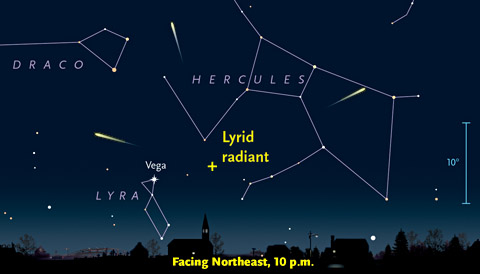Although typically weak, the annual Lyrid display will benefit from moonless skies. This year's peak, late on April 22nd, favors Europe over North America.
This month’s Lyrid meteor shower isn't one of the year's strongest displays, but the Moon is only a thin, waxing crescent and so won't offer much competition. As with January’s Quadrantids, the Lyrids put on a fairly brief performance, and this year the predicted peak (23:00 UT on April 22nd) favors those in Europe but comes too early for North Americans. (Those of you on the East Coast might fare a little better than skywatchers in the Far West.)

Sky & Telescope diagram
The Lyrid meteors appear to radiate from a location near the Hercules-Lyra border, which is high in the sky from about 11 p.m. until dawn.
To be honest, you’re likely to see no more than a few meteors per hour. At its best, this shower’s typical zenithal hourly rate (the number you could count under a very dark sky with Lyra near the zenith) is about 15 or 20. That’s enough to be clearly a shower if you’re watching and counting for an hour or more. But it’s a far cry from the 90 to 120 per hour expected on the moonless late nights coming up for this August’s Perseids and December’s Geminids.
The Lyrid meteor shower has been observed for more than 2,000 years; Chinese records say "stars fell like rain" during the shower of 687 BC. But in recent times the Lyrids have generally been weak, though at intervals of about 12 years the shower occasionally delivers up to 10 times more meteors than normal. The Lyrids did show a brief surge to a ZHR of 90 in 1982, but a spike like that hasn’t been reported in any of the appearances since.
Such predictions are uncertain, because the orbital periods of the Lyrid dust particles and Comet Thatcher (C/1861 G1), which shed them, are about 400 years. It’s likely that the gravitational attraction of Jupiter perturbs these particles into separate, narrow concentrations within the overall Lyrid stream. Whenever Earth plows through one of them, we get quite a show. Dynamicists predict that major outburst might occur in 2040.
My S&T colleague Alan MacRobert points out that the half year from January 7th to July 7th has remarkably few meteor showers compared to the other half of the year, for no known reason but chance. Only the April Lyrids and the May Eta Aquariids make it onto lists of major showers, while nine or ten rich meteoroid streams intersect the other side of Earth’s orbit.
 4
4
Comments
George Gliba
April 22, 2015 at 2:57 pm
From Mathis, West Virginia under clear skies I was able to get in two hours of pre-maximum Lyrid meteor observing this morning and rates were about what was expected. Under clear skies from 6:03 to 8:03 UT, with a LM=6.25, I was able to see 12 Lyrids. The best Lyrid was a -1 Lyrid seen at 7:02 UT. The average Lyrid was 1.9 magnitude and yellow in color. Happy Earth Day!
You must be logged in to post a comment.
Mark-Adams
April 23, 2015 at 10:07 am
I saw 11 Lyrid and 13 sporadic meteors in an hour this morning (23 April, 7:30 – 8:30 UT) under a decent dark sky (LM= 6.0) near Charlottesville, VA. The most impressive was a -2 Lyrid that crossed Draco & Ursa Major & left a 3-second train.
You must be logged in to post a comment.
George Gliba
April 23, 2015 at 3:27 pm
From Mathias, West Virginia I was able to get another two hours in this
morning and rates were higher than expected near the end of the second
period during an apparent mini-outburst. Under clear skies from 6:00
to 8:00 UT, with a LM=6.5, I was able to see 25 Lyrids, but 14 of these
Lyrids were seen during a brief 12 minute mini-outburst from 7:44 to
7:56 UT. The best Lyrid was a nice -2 Lyrid seen at 7:38 UT that had a
2 second train and a yellow-orange-blue color. The average Lyrid was 2.8
magnitude and yellow in color.
You must be logged in to post a comment.
April 26, 2015 at 11:48 am
From Little Lepreau, NB, Canada, over a 3 hr watch and dark skies on Apr22/15 I got 6 Lyrids. They seemed rather faint and kind of slow as far as shooting stars go. I got the yellowish color as well and they seemed to be scattered across the entire sky as opposed to being in just one area. My report with some images taken that night can be soon on my blog http://observingreports123429.blogspot.ca/
You must be logged in to post a comment.
You must be logged in to post a comment.